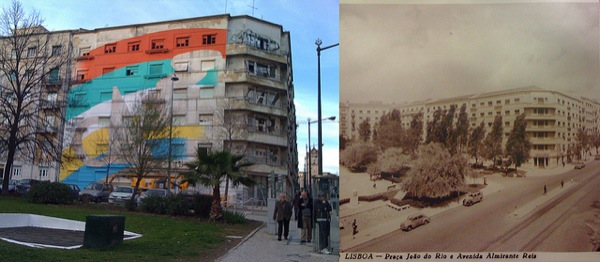
Chanced upon this incredible wall in Lisboa that MOMO just uploaded to his flickr site with a comparison of the mural with the original site.

Chanced upon this incredible wall in Lisboa that MOMO just uploaded to his flickr site with a comparison of the mural with the original site.
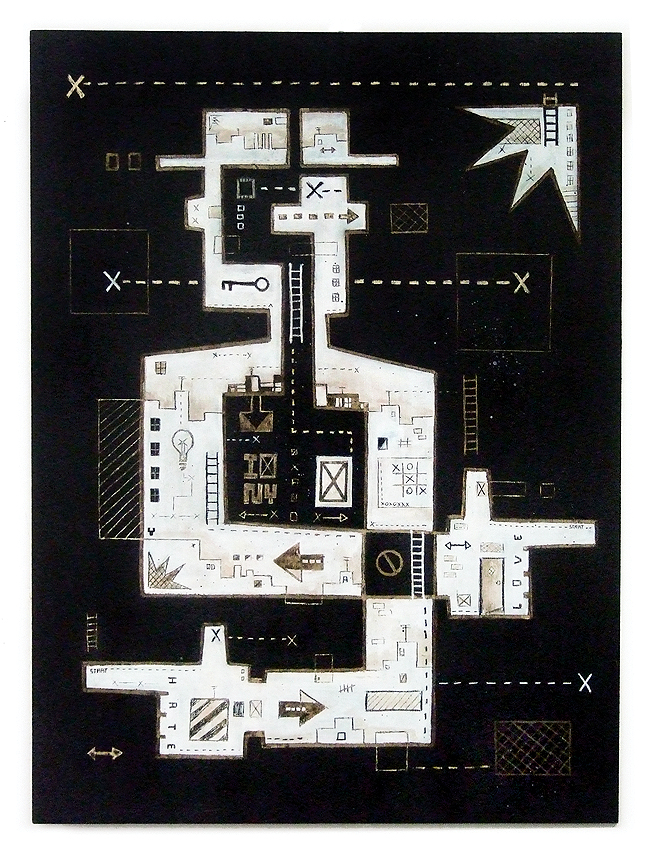
During the build up to his upcoming solo show at London’s High Roller Society, I caught up with Ad, twin brother of Droo, and half of Brooklyn based Skewville who have been pushing the boundaries of street art for well over a decade with their iconic sneaker art.
After learning that his favourite colour is Vermillion Orange and that he doesn’t care if you buy his art because his mum likes it and will always give it a home, we sat down and had a chat…
Shower: Hey Ad, welcome to London.
Ad: Yo, Yo!
So your new show is titled Slow Your Roll – can you explain a little about its meaning?
I wanted to play off the gallery name. High Rollers is kind of a pun off of actually doing painting, but the truth is that everyone in street art thinks they’re a gangster or a big shot after just doing something for a year or two. So, kind of the idea was sort of to tell everyone to check their neck and to slow your roll, as a lot of people haven’t put the time in on the streets or even in an art career. Going back to that whole Mr Brainwash thing, you shouldn’t just be able to pop up on the scene and become big time. For me and for Skewville it’s just a way we have developed our style, kind of seeing what everyone else has done too, and soaking it all in. It should take your whole lifetime to develop what you’re doing.
The truth is though, we have been doing this a long time, me and my brother, and in the beginning when we did shows with our sneaker art and that kind of stuff no one actually gave a shit. And then later on street art became popular and then everyone wanted it, so then it came like I’m not just giving you stuff if you only want it now because it’s popular.
That certainly makes sense. With regard to London, is this your first solo show in the city?
In London? Yeah.
And how do you view the street art scene over here? Does it differ to Brooklyn?
When I was here in 2004, I thought that the street art that was here was pretty amazing. But I guess that’s because I was pretty new to the scene back then. ‘Cos in New York there was just a load of tags and you get a couple of good pieces, but when I came to Shoreditch I thought “Wow,” I was amazed at how bombed the streets were. But now the problem is that’s it’s all that same kind of style and not much has changed.
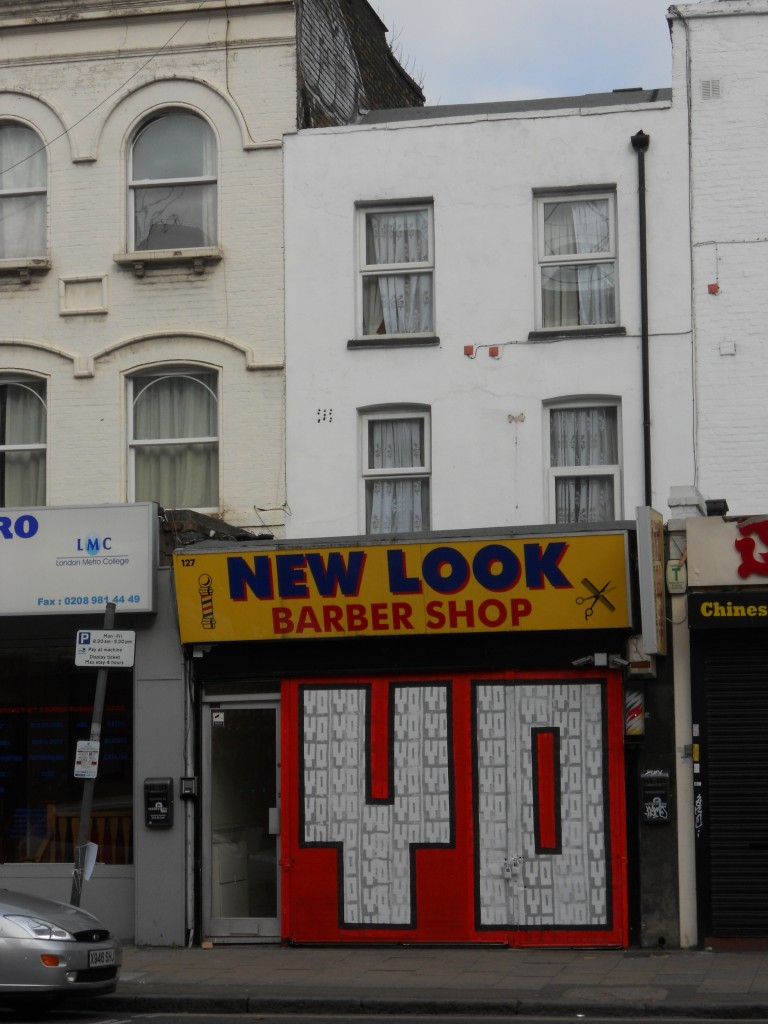
Currently London is witness to an ever increasing level of buffing thanks to the upcoming Olympics in 2012. How does your street work fair when it comes to graffiti removal teams?
That was the whole thing why we first started putting up sneakers. We were doing graffiti in the 80s when it was actually cool but then it kind of died out. Then in ’99 when we first started, it was actually Shepard Fairey’s 10 year anniversary, and I think there was only WK, Bast and a few people out on the street. There were a lot of posters and stickers, and the streets were already cluttered with a lot of stuff, so it was just about coming up with this new media space and new outlet to put stuff up. And it was also just mimicking that New York style of throwing up sneakers. The beauty of our stuff is that it’s kind of untouchable; you can only get it if you climb a pole or you have to just wait ’til they fall.
Are you still throwing your sneakers up now?
Yeah, but after 10 years and over 6000 pairs I’ve kind of slowed down a little bit, but its still something I do everywhere I go no matter what.
Do you have any for this visit?
I only bought a couple of pairs here because I know there aren’t a lot of wires and I always pack my luggage with as much weight as possible. So this trip is more about the show than the sneakers. And it was mostly because I knew people only cared about the sneakers so I wasn’t going to just give it to them!
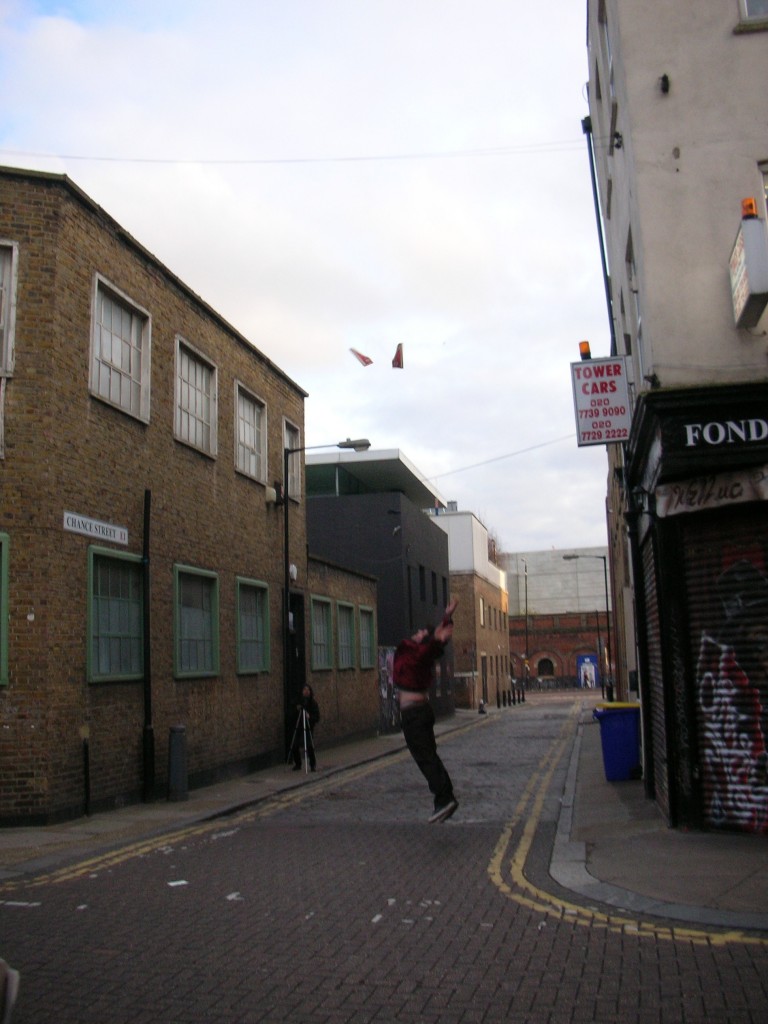
You mentioned that you have been throwing up for sneakers for over 10 years, but how long have you been producing work for indoor shows like this one?
We started back in 2002. My girlfriend wanted me to move in with her and I was like, “I’m not moving to the city unless I have a space that we can do something with.” So my girl found this spot and we moved in there and had our first show. ‘Cos before that I did try to approach different spaces to do art shows and I just got rejected. So that was the whole point, we just started our own space to show our own shit stuff and not have to deal with any of the politics. And then from having that show the response was “Oh you’ve done your own art show, oh cool, now I’ll do an art show with you.”
So it’s really all about making a name for yourself. Once you have done that everyone wants in.
Yeah, which is what I can’t stand about this whole scene. ‘Cos there are a lot of talented people but because no one knows them they don’t get the respect they deserve, it’s often a vicious cycle. That’s what sucks about the commercial side.
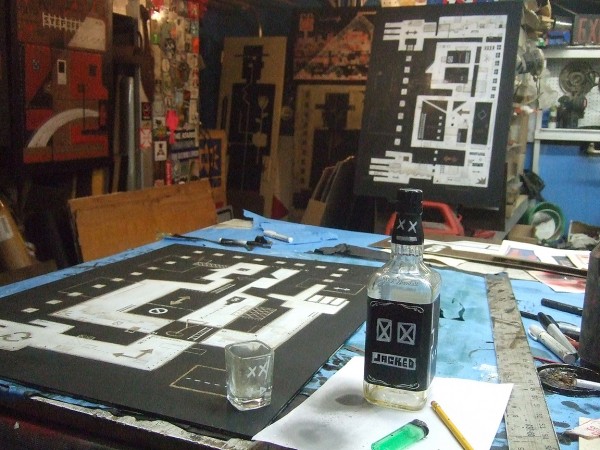
A lot of your work is quite sculptural, for example your iconic Blah Blah Radio pieces. Was this a bi-product of the move into producing more work for a gallery setting or has style always been a part of Skewville alongside your sneakers?
It’s unfortunate that Droo can’t be here because he kind of developed that 3D style. I think we were just doing sneakers on the street from about ’99 until 2004 and then when we were doing more shows people were just calling us ‘The Sneaker Guys’. And I’m friends with Mike De Feo who’s ‘The Flower Guy’ and he hates being called that, and we do too because we’re artists that do twenty different other things.
So my brother started pushing towards the sculptural stuff. I went to school for advertising and design, and my brother went for architecture, so when we started getting to do more stuff he started branching out into doing sculpture, 3D letters and all that other stuff.
Do you find yourself viewing exhibition spaces such as the street and the gallery in different ways? Does your work differ depending on which it is to be exhibited in? Do you even feel that your sneakers sit well in a gallery setting?
No, I don’t think that the sneakers work inside and that’s my whole problem with street art. Street art is art on the street. And the point of the sneakers was to make something that kind of blends in the urban setting. So you kind of do a double take. I love it when people say “Oh I see your sneakers and they go sideways, then I realise they are fake.” It’s kind of like a shock to see that but if you saw that in a gallery it wouldn’t have the same effect, plus you will never see some real sneakers just hanging in a gallery.
I think as we’re doing more shows we’re trying to keep the inside art completely different from the outside. So many artists will just do a silkscreen run, plaster it on the street and then put that same image straight into a show. This was street art, and in fact Shepard Fairey’s mission statement in the beginning – the whole point of putting stuff on the street was to counteract the advertising because the streets were cluttered. So you put up your art to counteract it but what’s happening now is that everyone is using their art as advertising so they have pretty much shot their own revolution in the foot.
This all made me want to do what I do on the street less and less, and kind of develop my style. All the stuff you will see in the show I started to develop way before I was putting up sneakers. So when people see this and say, “I really like your new work,” I say, “No, this work is way older, you just never gave a shit about it back then.”
I suppose it comes back to that whole ‘once you’ve had a show you can have another with us’ mentality.
Yeah exactly. But I was going to say before, that if everyone loved the first show I did and it sold out, I would probably be an asshole and just be doing the same stuff. So it’s kind of just my reaction to how New York treats New Yorkers.
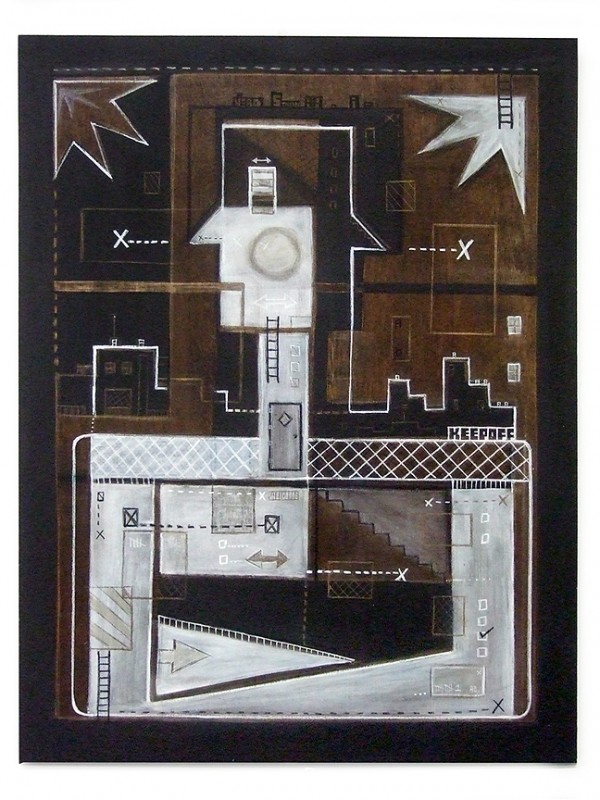
Do you think that that mentality consequently impacts on style?
Basically back in the day if you did letters and you kind of copied someone else’s style you would get your ass kicked. So back in those days, even though we were still in the graffiti realm, it was more about trying to be original and kind of trying to branch off. But today, everyone is just cutting stencils, everyone has that same kind of look, and everyone bites Swoon.
With regard to your own unique style, what and who are you inspired by?
I always hate to give people credit for stuff, but I guess I’m always influenced by others. In the beginning I used to do a lot of graphic design stuff like my posters for the sneakers. They were very graphic and someone said that they looked like Shepard Fairey, so literally the next day I stopped doing that style. For me, it’s more like if I feel I’m too influenced by something and someone sees that in my style it kind of makes me not want to do it. So I think I’m more influenced by the anti-influence of style and what not to do. ‘Cos someone might think that that’s a compliment to me, that I look like Shepard Fairey, but that’s not a compliment, that’s more for me to kind of check my style.
But just growing up, in 1984, me and my brother got Subway Art and that was the day when we started doing graffiti. So obviously as kids being about 10 or 12 years old you copied everything, but that’s how you were taught in school, to just learn how to do stuff. So I was definitely influenced by Subway Art and then also I was hugely influenced by Espo, Cost and Revs and even Shepard Fairey. Just seeing that stuff on the streets and thinking “Wow, this is actually really cool.” And what was good at that point was that it was kind of really underground and that’s what really influenced me.
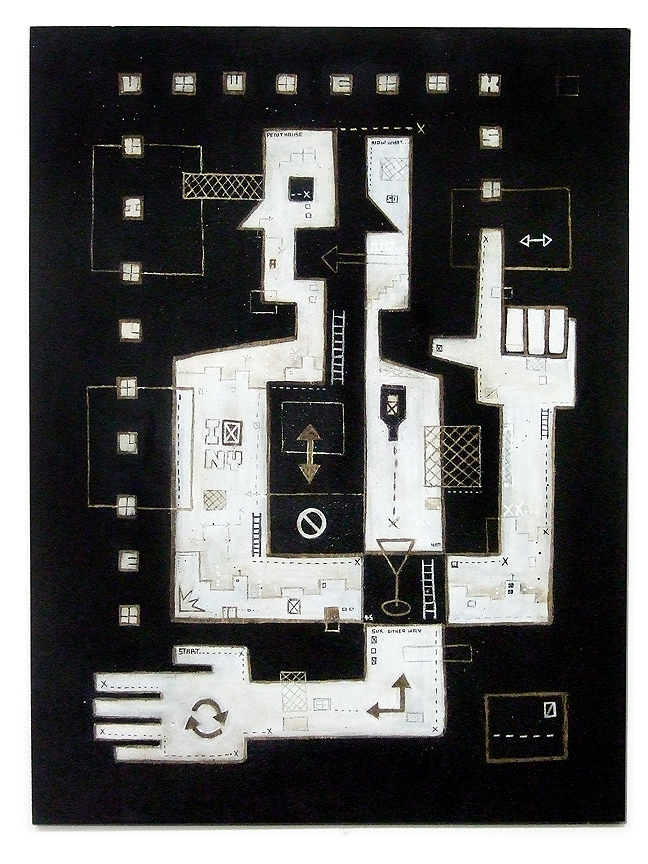
But I think if I was a kid now I wouldn’t really want to be a street artist today as its just way too saturated and everyone does it. I would probably really shy away from it which is actually what I’m sort of trying now, to get away from it. But you can’t ever do a show in a street art type of gallery and not say that you’re a street artist. So it’s this kind of catch-22 thing where you are labeled a street artist but what the fuck is a street artist?
You certainly know the revolution is dead when your mum starts telling her friends “Oh yeah, my son is a street artist.” And you’re like “Fuck, that’s not the whole point of this.” The whole point of being in graffiti scene is to go against the grain and that’s what street art should have been. And now it’s all about making money, flying to London, doing swanky shows and sipping tea!
Within this unique style certain words such as; Hype, Yo, Fresh, Beef and obviously Brooklyn, crop up on a regular basis. To me they almost become a modern take on the traditional tag but how do you view their use?
I guess it is kind of that, like a tag without trying to use the same word all the time. It’s great that when someone sees a “Yo” they be like, “Oh that’s Skewville.” And I didn’t invent the word “Yo,” and I didn’t even invent that typestyle, but it’s just so funny that someone’s like “That’s a Skewville font.” I think, “Ok, you obviously weren’t around 20 years ago when everyone was doing block letters.” So, I think it’s just our whole mentality of just changing stuff up and actually getting excited that now my tag is “Yo,” “Fresh,” “Beef” and all that stuff.
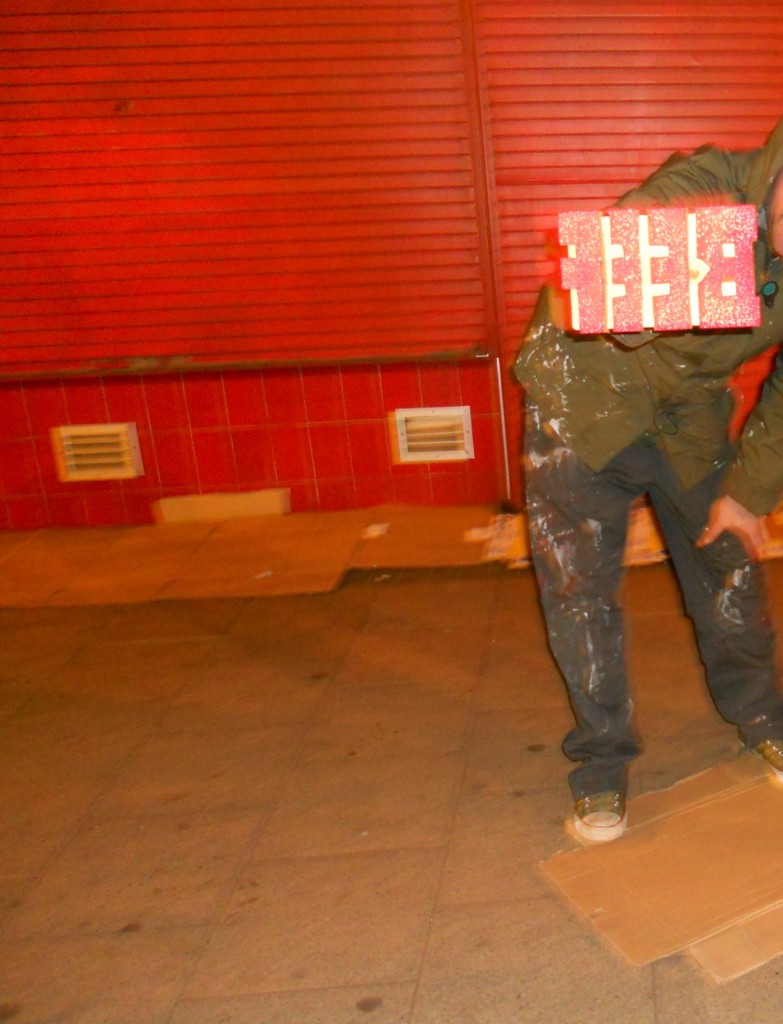
Can you explain a little bit about the use of materials in your work?
My brother uses a lot of metal, but I think I have always just stuck with wood as the whole sneaker project just started with wood and it’s just a nice material to work with. Not too many people use it, but I think if a lot more people started to use it and if more start to screenprint straight to wood I think I will probably not to use it.
Which piece are you most proud of, inside or out?
The one I’m going to do tomorrow, but I don’t know what that is yet. I dunno, it’s hard ‘cos every time I’m finished with something I hate it. Like the Beef piece, once I finished I was like “Ahhh I should have done the X’s in white” or changed it up a bit. I think any artist that falls in love with their art is dead.
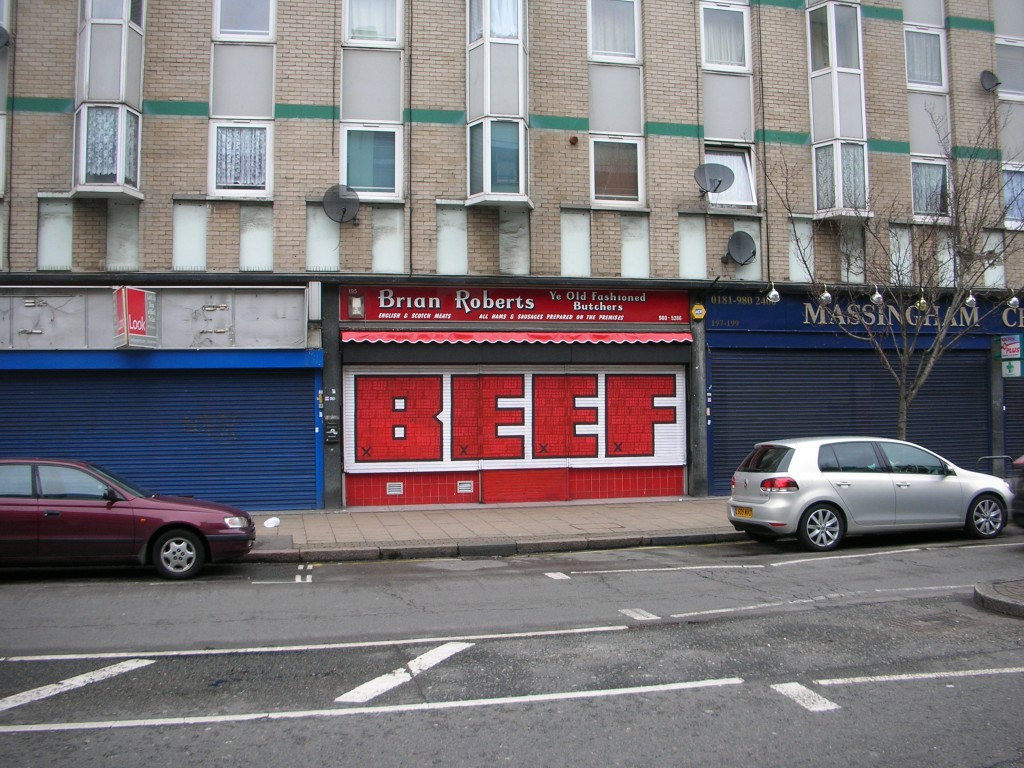
But I think the sickest thing I ever did was put up a set of sneakers in front of the Hollywood sign ‘cos that took 3 days to actually find the road that goes up there. And when we finally found it, there was a telephone wire at the bottom of the hill and from it the only word you could see was “Wood.” And that was of kind of perfect.
But actually the best one was in Dublin in front of a castle. It was just crazy to find a telephone wire in front something like that. It was my friend from Dublin that just drove us round to show us the neighbourhood and I saw the wire and I said “Just STOP,” and he said “There is no way you’re throwing sneakers here.” In my mind I wrote down what the street was and where it was, as it was about an hour out of Dublin. So he took us back into the city, and then I knew he went on vacation, so me and my girl took the train back out there just to take that shot. And then he saw the photo and was so pissed at me, that I had disgraced his castle. But I was never going to find that again. That’s kind of the problem with this project though: There needs to be a wire; it’s kind of a random thing.
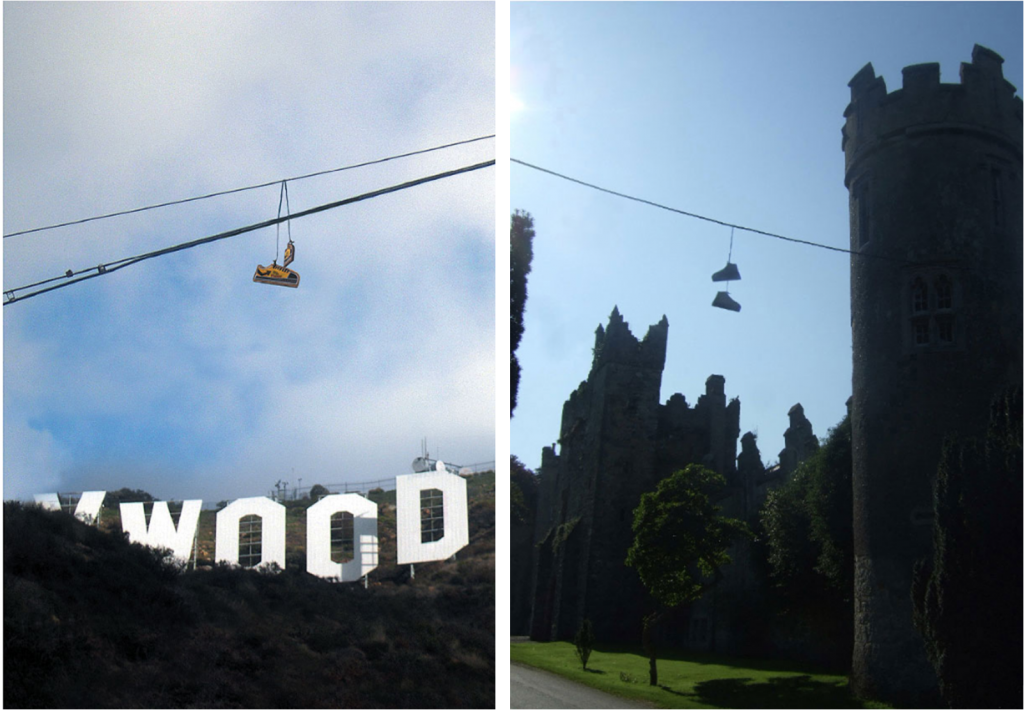
I would be surprised if you had passed up a spot like that! Finally, what do you see as the future for Skewville?
Wow… the future. I think I’m just going to keep doing what I’m doing and see what happens. I just hope I don’t get rich and famous ‘cos then I’m going to be an asshole and probably wouldn’t be doing an interview for Vandalog!
———–
Slow Your Roll opens at High Roller Society on Friday, March 18th at 7pm and runs until April 24th.
Photos by Skewville, High Roller Society and Shower
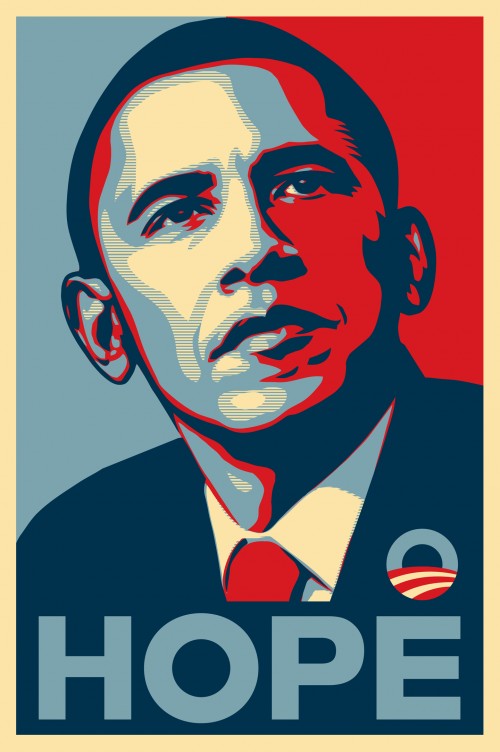
While the lawsuit between Shepard Fairey and the AP was settled in January, there was still a suit between Obey Clothing and the AP. That suit was finally settled, according to PDN Pulse. Both suits surrounded Fairey’s Hope portrait of Obama from a few years ago.
The terms of the settlement with Obey Clothing (as well as some of the retailers who sold clothing with Hope on it) include three important points:
1. Neither side is backing down and admitting that they were wrong. They both get to stick to their beliefs (the AP that the use of a photo they owned as the basis for Hope being infringement and Obey Clothing that it was fair use).
2. Obey Clothing “will not use another AP photo without obtaining a license from the AP.”
3. (and here’s why I say this series of unfortunate events is almost over) Obey Clothing “will collaborate to create and sell apparel using Shepard Fairey’s graphics based on photographs owned by the AP.”
You may remember these terms as sounding pretty familiar as they are pretty much identical to the terms of the settlement with Shepard Fairey, except dealing with clothing.
And yes, condition #3 does mean that there will probably a series of half-assed-and-photoshopped-in-5-minutes-to-OBEY-specification prints and t-shirts based on some famous photographs that the AP owns the rights to. Does the AP seriously think this is going to make them look good? I know people (including myself) have criticized some pretty low quality prints from Fairey from time to time, but damn, besides just the very real possibility of Shepard making some poor designs in a large enough series, I wouldn’t blame the guy if these upcoming designs based on AP-licensed images were intentionally half-assed just to spite the AP.
Or maybe I’m just writing spitefully because I wish Shepard had seen his day in court to patriotically defend the right of fair use… After all, I did buy a print from him last year.
Photo courtesy of Obeygiant.com
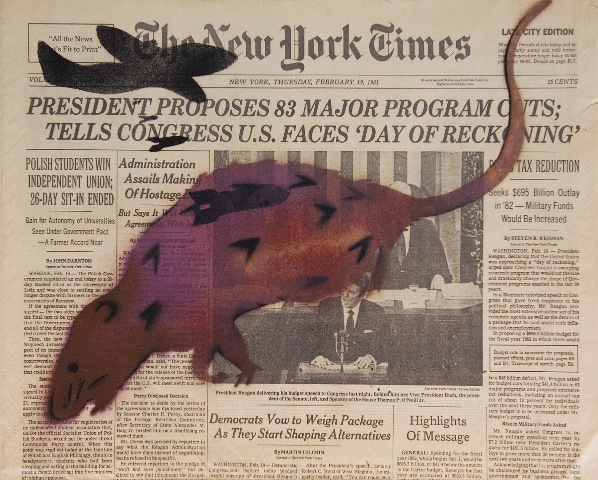
The next show at Shepard and Amanda Fairey’s Subliminal Projects promises to be one of my personal favorites there. Curated by Peter Frank and Lisa Kahane, Art, Access & Decay: New York 1975 – 1985 looks at one of my favorite periods of street art, one that I think is consistently underrated in favor of the graffiti from that time (or else solely represented by Haring and Basquiat, like representing today’s street art solely with Shepard Fairey and Banksy). The show draws heavily from CoLab, Fashion Moda and the East Village artists of the time.
Artists include: John Ahearn, Liza Bear, Andrea Callard, Thom Corn, CRASH, Jody Culkin, DAZE, Jane Dickson, Stefan Eins, Coleen Fitzgibbon, Mike Glier, Robert Goldman, Ilona Granet, Keith Haring, Julie Harrison, Jenny Holzer, GH Hovagimyan, Becky Howland, Lisa Kahane, Christof Kohlhofer, KOOR, Joe Lewis, Michael McClard, Ann Messner, Richard Miller, Joseph Nechvatal, Tom Otterness, Cara Perlman, Virge Piersol, Walter Robinson, Judy Ross, Christy Rupp, Teri Slotkin, David Wojnarowicz and Martin Wong. I don’t know everyone on that list, but it seems to me to be pretty comprehensive and catch most of the major names (minus Basquiat, John Fekner, Don Leicht and Richard Hambleton). Especially cool is the inclusion of Wojnarowicz. Most people don’t realize that he did street art. And I guess the same could probably be said of Jenny Holzer.
I’m excited to see that someone has put this show together, especially at a space like Subliminal Projects. Street art history does not go: Haring to Blek to Beautiful Losers to Banksy, and this early period is well worth a closer look.
And of course, the timing for this show is very intentional. Art, Access & Decay opens on April 2nd and runs through the end of the month. That mean that LA MOCA’s street art show will open dead smack in the middle of Art, Access & Decay‘s run. I will definitely be making my way over to Subliminal while I’m in town for MOCA’s exhibition.
Photo courtesy of Subliminal Projects
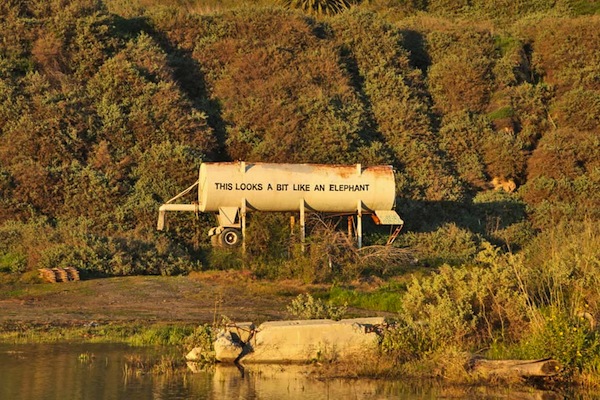
UPDATE: Before Banksy came along, a man had been living in the tank for 7 years.
Melrose and Fairfax, and LA-based street art blog, has been following the Banksy drama in LA very closely (check out these posts – although that last one is basically a forum user pulling claims out of thin air which may or may not be true M&F points out that The LA Weekly has backed up some of the claims in that last post, which seems a lot more reliable to me), so of course, they were the first to discover that the above Banksy, recently painted on an old water tank as part of Banksy’s pre-Oscars campaign in LA, is for sale. Banksyelephant.com is attempting to sell the tank. While the site claims that the owners “personally acquired ownership to preserve and protect the work of Banksy in hopes that it will end up exhibited in a respected museum where his work will live on without harm,” I think it’s safe to say that money was a bit of a motivator too. Of course, Elephant will never get Pest Control certification (they do not certify street pieces) and without that, the value of a work by Banksy drops dramatically.
Historically, the water tank has been a bit of an eyesore that residents have tried to get rid of, but the owner would not remove. Melrose and Fairfax wonders if maybe Banksy was aware of that history and painted it knowing that the owner would finally remove the tank in order to try to sell or protect it.
Photo from Banksy’s website
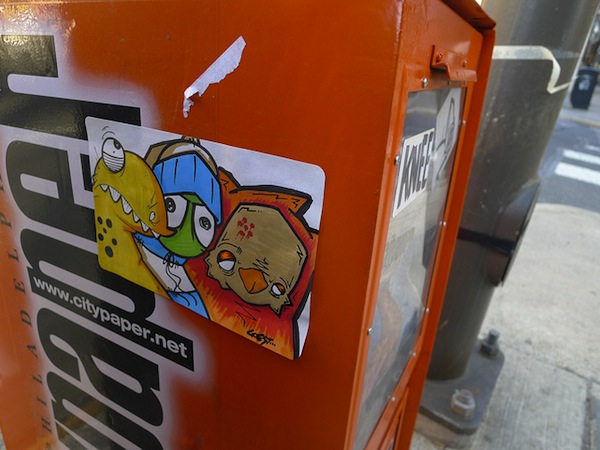
Following up on last week’s post about the sticker art in Philadelphia, here’s part two of Vandalog’s series on some of the top sticker artists in Philadelphia. Thanks again to El Toro for his input in developing this list. Here are the artists (in no particular order):
1. Roger
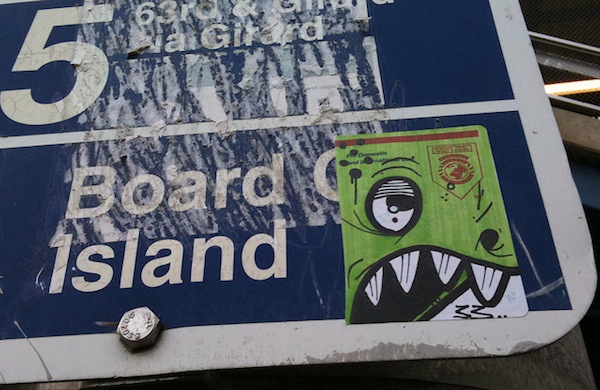
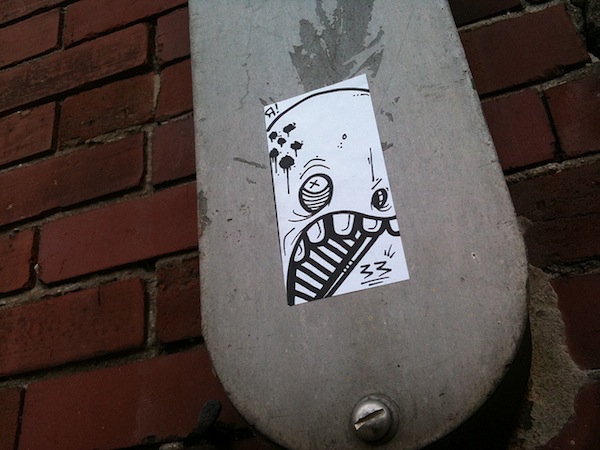
2. Radius
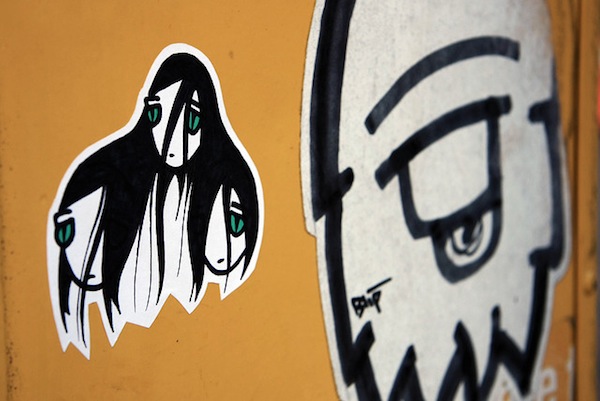
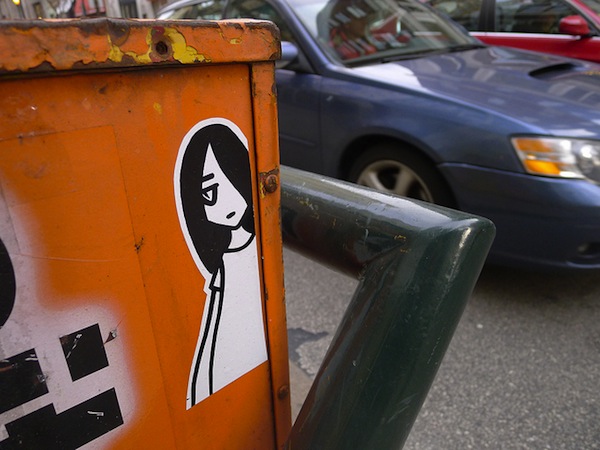
3. Gonz
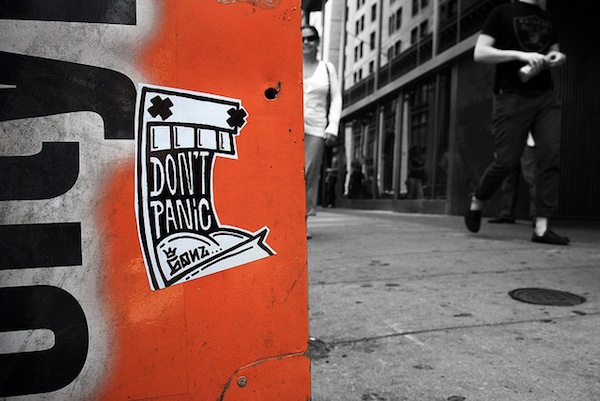
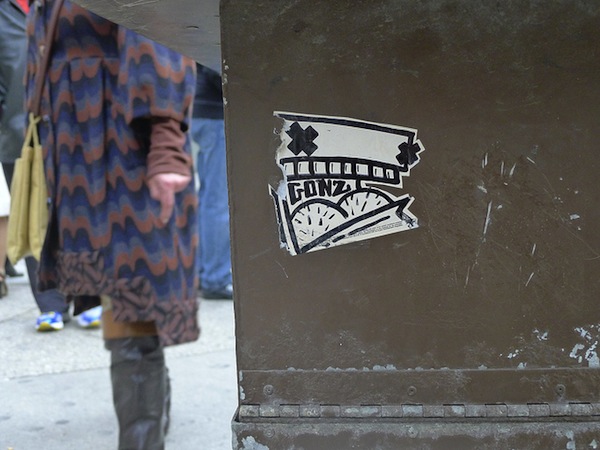
4. WTF and Dash
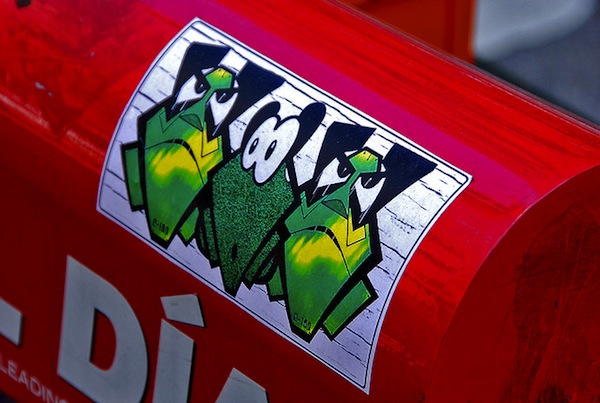
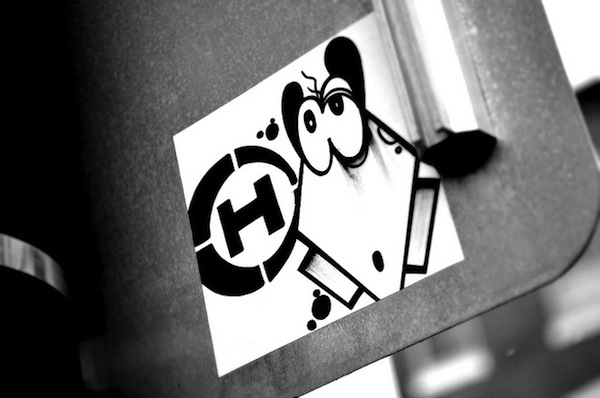
5. Two artists I’m liking whose names I don’t know (but let me know if you do)…
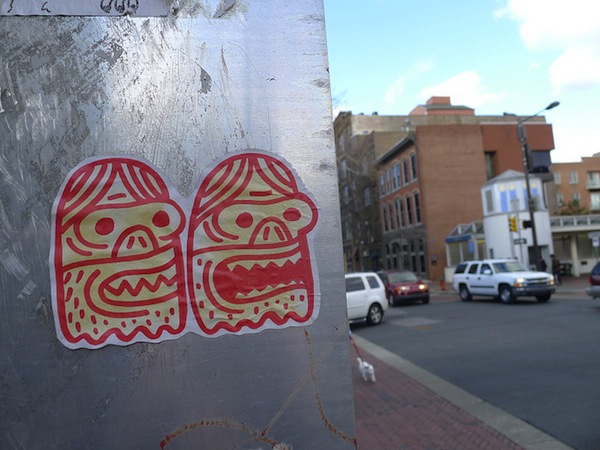
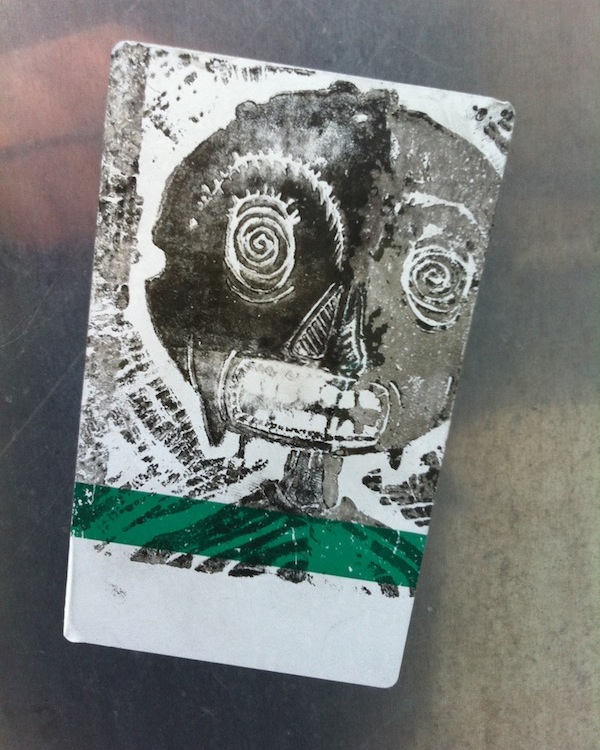
Photos by RJ Rushmore, Damonabnormal and Roger
In the 70’s, only a few artists were using the streets as way to reach out to people, communicate and ultimately make art. Accompanied by Don Leicht, his long time collaborator, John Fekner brought art and help to areas in New York that were in need at the time. “Decay/Abandoned” , “Wheels Over Indian Trails”,”Post no bills, Post no dreams”, etc were only some of the hundreds of messages John spray painted all over New York. What some might have called vandalism, some others saw as a welcoming statement, and some others saw as a sign that things needed to get fixed in the city.
I have to say, having the chance to interview John Fekner was truly an honor. I hope you enjoy the interview as much as I did. This interview an excerpt from the exhibition catalog of the upcoming exhibition, PANTHEON: A history of art from the streets from New York City. Please support their Kickstarter, they only have a few days left to reach their goal.
To find out more about John Fekner, please visit his website (lots of cool stuff in there).
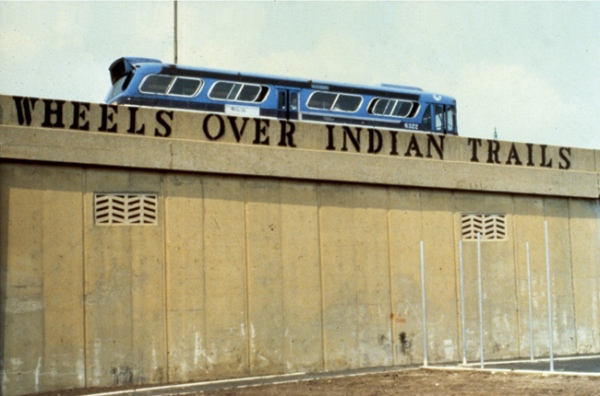
I know you have lived in New York your whole life, and started to do public art back in 1968. What drove you to make art in public areas?
I was a city kid, as soon as I stepped outside it was hard: concrete, asphalt, jackhammers, traffic lights. Long Island City factories were a few blocks away. Summer was handball, winter was roller hockey, and so on. Always in the street-Sunnyside, Woodside, Jackson Heights. The first outdoor text was in the Heights, where I hung out as a teenager in 60s. At seventeen, with few friends I hung over the roof of the park house and on the front we painted the phrase Itchycoo Park in two-foot letters.
What about living in New York influenced your work?
The soot belching out of apartment rooftops, chimneys, diesel engines and the smell of jet fuel near La Guardia—a love/hate with industry and technology.
You and Don Leicht have been collaborating for years. How and When did you and Don meet?
We met in graduate school in the Bronx in 1973. The first crit class we had we both showed up with invisible work-mine were portraits and his were abstract narratives. Everyone in the class was stunned- they couldn’t see anything…so we really hit it off…fellow Libras-born in October.
When did you both decide to start collaborating in art?
When we shared a studio at P.S. 1. In 76. We were both placing hidden artwork and drawing on the walls in and around the building.
What is it about collaborative work that you enjoy the most?
Collaboration is the closest I get to working in a band setting. With Don, ideas are exchanged, the visual journey take twists and turns and ultimately you make a combined image that works. Sometimes he plays lead, sometimes I take over at some point. The finish painting is a blend of both of us…it isn’t about he painted this and I said that. Sometimes it completely opposite from what it appears to be. It’s like a lyricist and a piano player. Sometimes the words comes first, sometimes the music or vice-versa. You play off each other’s input.
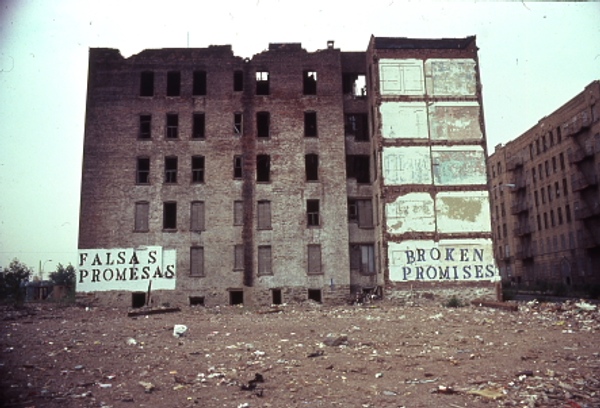
The Warning Signs project brought attention to areas and communities in need of help at the time. Could you tell me a little about this project and how it helped you develop into the artist that you are now?
I was paying a lot of attention to my immediate environment and questioning why something was broken and not being repaired. I tried to emphasis the problem that other people blocked out of their vision-I made it more visible. Issues pertaining to the human condition and the environmental are still as important to address and are in newer works, whether it’s a video or a series of paintings.
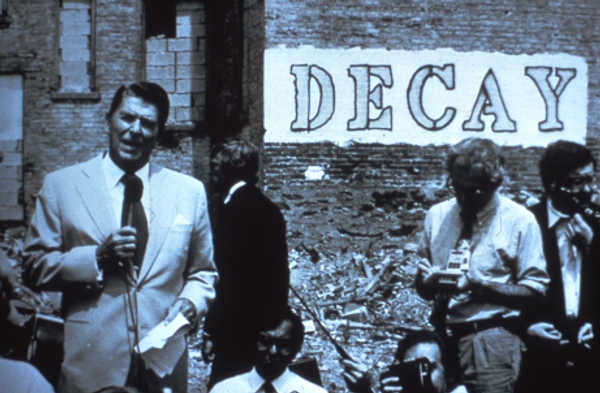
When researching about your work I found out that you studied poetry as a teenager. How does poetry influence your work?
Poetry is like life- you are in moment and then it’s gone. A brief reflection on life-one instantaneous boom-and you move on..a few seconds of a lifetime captured in a few words.
What inspires John Fekner?
Discovering or unearthing something that strikes an immediate chord and compels me enough to immediately react and create something new in the appropriate media.
Your favorite place in NYC?
Listening for that eternal echo under the Sunnyside viaduct: http://www.flickr.com/photos/41101207@N00/2195426639 And any street in NY that still has cobblestones; reminds me of family and friends who are no longer here. And walk those streets on a holiday morning very early when no one is around…it feels like Edward Hopper will walk right by you..
You usually work with stencils and metal, why stencils? And why metal?
Stencils have that official proclamation thing going on… Don’t Touch – Don’t Enter built into it. Metal has an industrial aura and is a reflection of our environmental destruction filled with the other culprits: plastic and rubber. It’s so unnatural but is natural to us city dwellers.
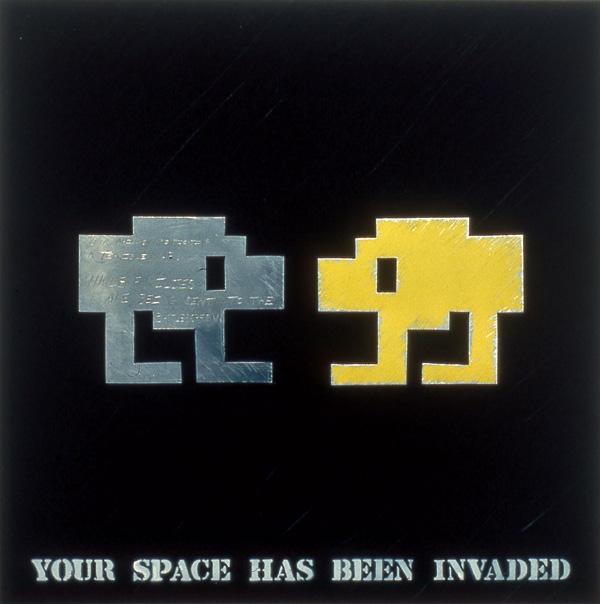
And then there is music and multimedia.How did you ended up working with computer generated work and video?
The idea of using new tools such as audio and video began in the mid-70s with the advent of the Sony portapac camera which was not that portable! DIY was a big thing so having audio/film camera equipment to document the stencils was natural. In 1981, NYU invited Crash, Keith Haring, Warhol and myself to experiment with a new computer and that’s where I created Toxic Wastes From A to Z (coming after you and me).
Hip Hop seemed to be a big influence in your life and art. Would you tell me the role music plays in your life? any last recordings, and your feelings about music back then and now?
Artists like Laurie Anderson, Alan Suicide were all doing art/music at the same time in the 70s. I began recording in my friend’s basement in the late 70s and had audio components as part of my indoor installations. By the winter of 1979 I was spending a lot of time up at Fashion Moda and just picked up on the beats/raps and then made a few records with Bear 167 from the South Bronx. Still like to add musical components on the video pieces. Recently I’ve been listening to some different things like Lower Dens, Animal Collective, Panda Bear, Woodsman, anything that sounds incomplete, like a backing track-I dig that!
How do you feel about the street art scene in New York nowadays?
Street art is the fastest visual conductor out there beating out advertising, guerilla marketing and social media. There is always something different to see somewhere around the world. It’s always the young that bring sometime new to the street, but unfortunately, they don’t stay young for very long. Careerism, branding, promotion-driven projects get in the way of who you really are. Then the next trap, like striving to become part of a gallery’s stable of artists; what am I…a horse? But that’s how the gallery system treats and controls you.
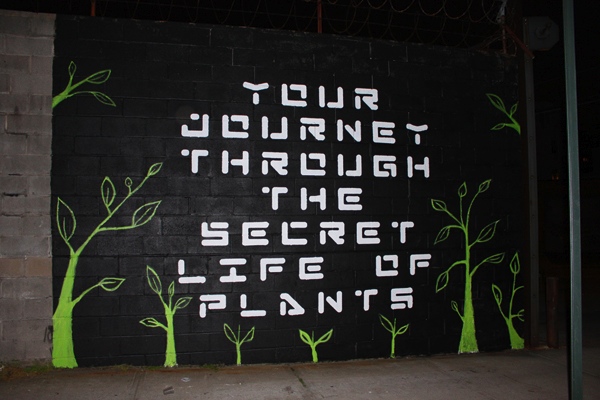
Favorite street artists?
There’s a young kid around the block who works with colored chalk. She absolutely never does the same thing twice. I don’t dare talk to her. I can’t wait for warmer weather to see what she’s up to next. That is the essence of a great street artist. There’s consistency, she will be at the same spot. I’m not a wall-trippin’ round the world guy. Offhand, Stephen Powers Love Letters was very cool. Great connection to the community.
Any new projects coming up?
New paintings with Don Leicht in the studio and there’s my STREAMDROPSTRASSE text work in photo streams http://blkriver.at/ and the ongoing Stanley Cup project plus some hidden projects around as well.
All photos courtesy of John Fekner Research Archive @1979, 1980, 2011
Presidential Candidate Ronald Reagan in South Bronx @AP/Wide World Photos 1980
Your Space Has Been Invaded ©Peter Bellamy 1982
Mother Earth Will Survive Welling Court Mural Photo: Lukwam 2010
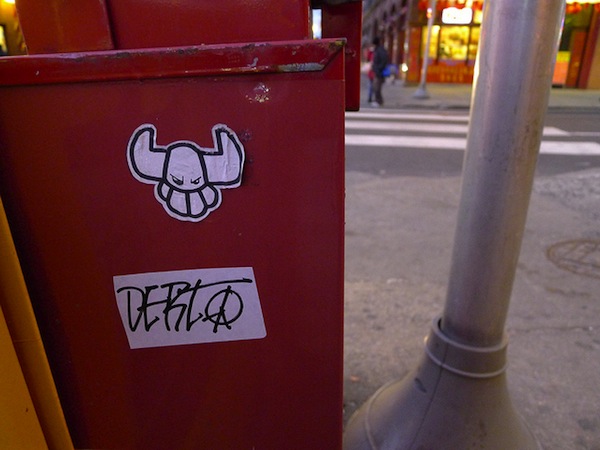
Although I’ve been living outside of Philadelphia for about 6 months, it’s only recently that I’ve begun to get a handle on the street art in Philadelphia. The overwhelming trend here is stickering, particularly by artists who draw logos instead of names. Given that my favorite art book of last year was probably a book about stickers, this is a coincidence that I’m loving. I wanted to do a post or two about some of Philadelphia’s best sticker artists, but realized that I am definitely not an expert on the local scene. Luckily, El Toro was happy to help me out in compiling the majority of this list. Also, a big thanks to Damon Landry aka damonabnormal for being such a dedicated photographer of these stickers and allowing Vandalog to rely heavily on his photos for this series. So here’s the first of two posts on some of Philadelphia’s best sticker artists (in no particular order)…
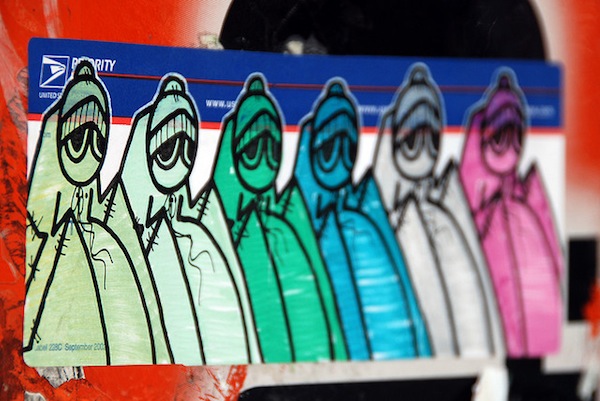
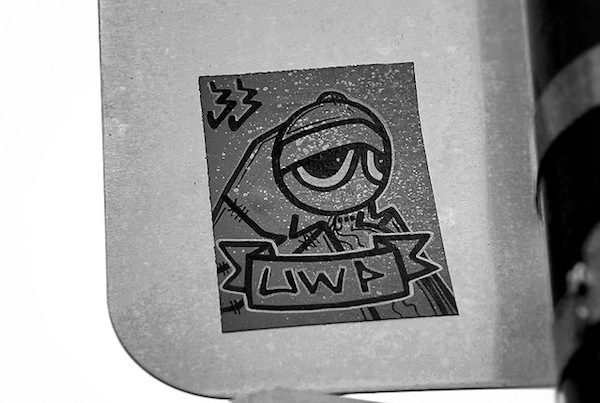

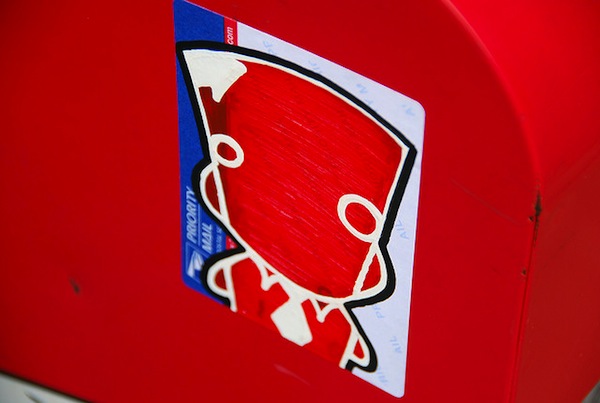
3. Bad Dog
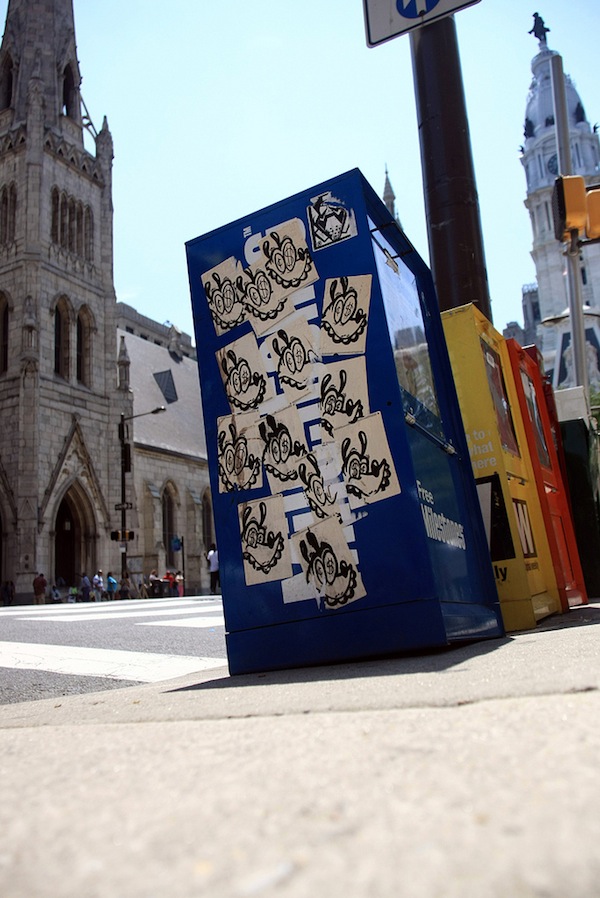
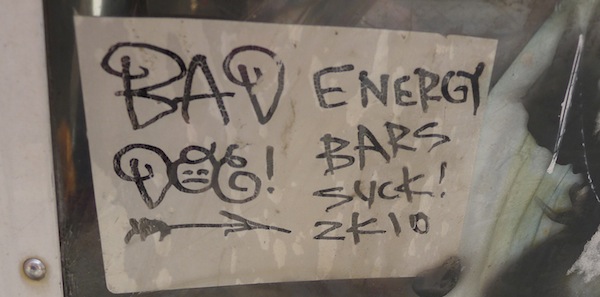
4. El Toro
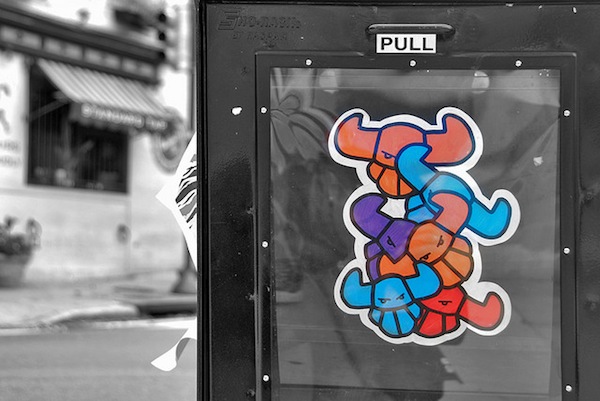
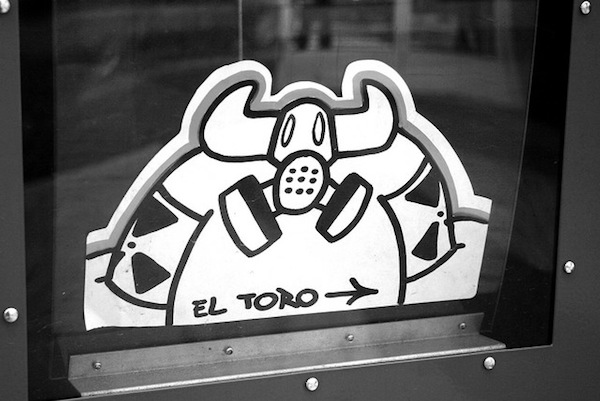
5. Ticky


Photos by damonabnormal and RJ Rushmore

Next week, Know Hope will be launching his latest book in Tel Aviv. Bound By The Ties is a 160-page full-color book from one of my favorite young street artists. Know Hope’s work really tugs at the heart strings, and I think that the impact of his art is strongest when seen en-masse, so a book like this seems like a perfect way to view his art.
Know Hope describes the book as “a collection of drawings, writings, photographs and other side-seen moments, some from the recent past, and some from very close to the present” and “a folk tale of some sort, collective memories compiled like a time-capsule, or fireworks in a jar.”
For those in Tel Aviv next Thursday, there will be a launch event where you can be among the first to see the book. You can find more info on Know Hope’s flickr. That launch will include a display of all of the original drawings and texts used in the book.
Bound By The Ties is printed in an edition of 1000. There is also a special edition of 75 which each have unique handmade covers.
On Friday March 11th, the day after the book launch event, Bound By The Ties will be available online.
Photo courtesy of Know Hope
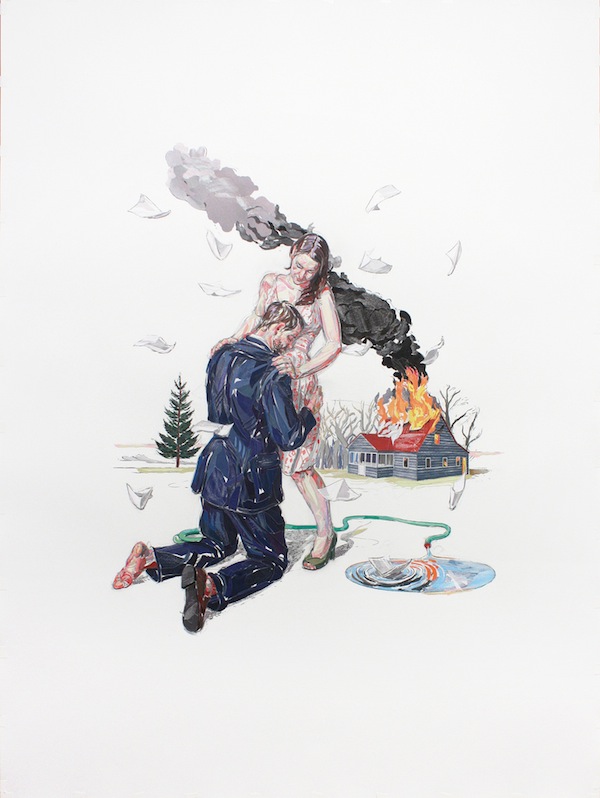
Next week is going to be a big one for Brian Adam Douglas, aka Elbow Toe and his UK fans. Due Dates, his solo show at the Warrington Museum in the UK, will be moving to Black Rat Projects. Due Date opens next Thursday evening, March 10th. If you already saw Due Date at the Warrington, it will still be worth checking it out again at Black Rat Press, as the show will include one very special collage that has not been seen before. Additionally, the relaunch of Due Date at BRP will double as the launch for his first book, Paper Cuts.
Photo courtesy of Elbow Toe